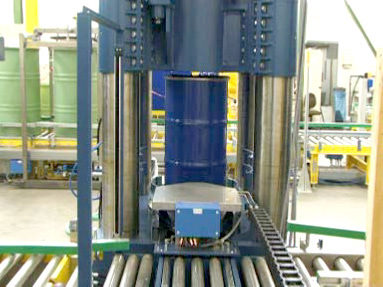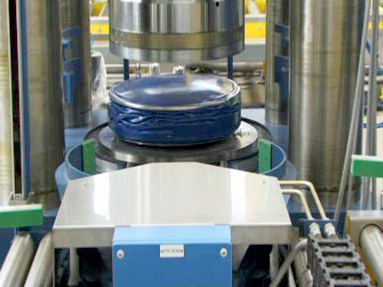Background
Compaction is a viable treatment technology for volume reduction of various waste streams, including activated metals, glasses, contaminated solids, plastics, small equipment and tools, filters, compactable trash, wood, pipes, sludge and asphalt.
Westinghouse-design supercompactors have been in operation since 1982 in the United States and in other countries.
Description
The compaction process begins with delivery of radioactive waste to the supercompactor in mild steel crumble drums. The crumble drums are placed in the input position on the supercompactor feed conveyor. From there, they are transported to the input/output position of the loading/unloading device of the supercompactor. To start a compaction campaign, the venting of the drum mold of the supercompactor has to be in operation (heating, ventilation and air conditioning or separate ventilation). The compaction process can be performed in automatic as well as in remote-controlled mode.
To load the supercompactor, the loading/unloading device (pusher) grips the crumble drum in its lower area and transfers it to the compaction position that is located underneath the press plate (piston rod), on the base plate of the supercompactor. The loading/unloading device is then moved back, outside the compaction position. After positioning the crumble drum via centering devices, the drum mold of the supercompactor is lowered over the crumble. Now the centering device moves back into its parking position and the mold is completely lowered onto the baseplate. The piston rod is lowered down to the top of the drum and the compaction process is started.
The compaction force will be generated by hydraulic pressure in the main hydraulic cylinder of the supercompactor and the required hydraulic pressure is generated by the hydraulic aggregate. After the compaction process is finished, the drum mold is lifted up. The loading/unloading device grips the generated pellet, transfers it to its input/output position and places the pellet outside the compactor for further transport by the exit conveyor.

Supercompactor with delivered crumble drum of radioactive waste

Crumble drum after compaction
Benefits
The Westinghouse supercompactor offers volume reduction of the waste without changing the chemical properties. The resulting pellets are easy to handle and can be put into uniform overpacks (e.g., drums or containers). The supercompactor offers the following features:
- Loading of capped crumble down (with waste) into supercompactor
- Piercing of the drum, if required
- Effluent collection tank
- Ventilation line to high-efficiency particulate air filter (separate)
- Compaction of drums to pellets
- Removal of pellet from compactor
- Measurement of pellet (height, weight, dose rate) for overpack optimizing
- Hydraulic unit and capping device for drums
- Use of different drum sizes (e.g., 160, 180, and 200 liter)
Experience
Since 1982, Westinghouse has been supporting supercompaction operations in both the United States and in other countries, including Germany, Italy, France, Belgium, Korea, Taiwan and China.
We recently built five sorting and compaction facilities in China and are building one in Austria. Further, a radwaste treatment facility in China is equipped with a supercompactor for dry waste volume reduction and for hot resin supercompaction.



